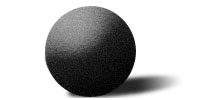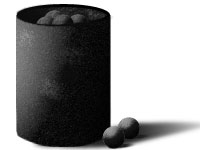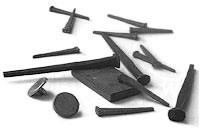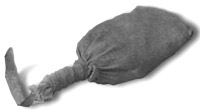
What Shot Out of Cannons
 |
Cannonball
Solid cast iron balls were shot at anything.
These did not explode. The technology for such wasn't there
- yet. Nevertheless, even against massed infantry, these balls could
be devastating. Fired to angle horizontally through a
formation, a single ball could chop a bloody swath*; it
could even be made to skip along the ground through a group
like a flat stone across water, amputating and disemboweling
as it skipped. |
 |
Canister Shot -
Small Ball
Of somewhat smaller diameter than
the cannonball, such shot was usually round balls
placed inside a canister, which was often metal but in a
pinch could have been something else like leather. The
projectiles could be pre-made specifically for this purpose
and were usually larger than musket balls. Should the balls be packed
inside a cloth bag instead of a can, the collection was
dubbed "grape shot," for it resembled a bunch of grapes. |
 |
Canister Shot -
Assorted Metal Objects
An alternate to
small-diameter metal balls for canister shot was whatever
came conveniently to hand, such as scrap metal, nails, links
of chain, etc. The canister acted as a sleeve to carry this
aggregate along inside the barrel during firing.** Due
to the lack of any aerodynamics whatsoever to these sorts of
projectiles, likely their range was not as far reaching as
that of ball. When a breach was made in the defenses
of Siena in 1555, the defending commander,
Blaise de Monluc,
had four or five heavy cannon, he wrote, "each loaded with
great chains, nails and pieces of iron," fire at attackers
stepping into that breach. |
 |
Canister Shot - Stone
Suggestive of the time when stone shot was still made for
cannon, small stones, like flint fragments, were sometimes
used in place of metal for canister shot. This
projectile was recovered from the wreck of the Mary Rose (which sank
in 1545) with the flint chips within a wooden cylinder,
which presumably would break apart when exiting the barrel.
The warship had several small-bore swivel guns on her top
deck. |
 |
Hail Shot
Hail shot was most often musket balls in a small cloth bag,
the opening tied off. The bags were fist-sized or
smaller and fired from small-caliber cannon like a falconet.
Into any group of attackers, the shot would rip like hail,
as its namesake would on a sprouting garden. |
* Robert Monro, in His Expedition With the Worthy Scots
Regiment Called Mac-Keys, described the "after" of 14 soldiers
decapitated by one cannonball. (Munro also described
this bloodless hit of a single cannonball: "...by this time there
is a Barrell of beere sent us, from the Leager, the Officers for
haste caused to beate out the head of it, that every man might come
unto it, with hat, or head-peece, they flocking about the waggon,
whereon the Barrell lay, the enemies Cannonier gives a voley to
their beere, which, by Gods providence, though shot amongst the
mid'st of them, did no more harme, but blew Barrell and beere in the
Ayre, the neerest miss that I ever did see; for many of them were
downe to the ground..." pg 30, ed. William Brockington, Jr., Praeger)
**Some motion pictures that show cannons being loaded have had the
crews shove the scrap metal directly into the barrel, without
benefit of can. Based on my personal experience with
small-caliber firearms, I would think that repeated discharges of
scrap only from a cannon would cause premature wear, even scoring,
on the inside of the barrel. Worn and scored barrels would
corrupt aim and lessen muzzle velocity of cannon balls. Cannon
were expensive to make. What cannoneer would wish to
damage his valuable weapon? One television production, "By the
Sword Divided," did show nails poured into a canister as it should
have been done.
Close this panel





